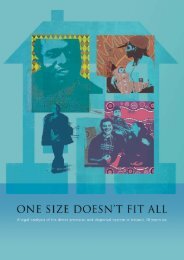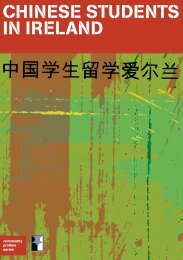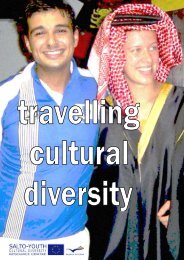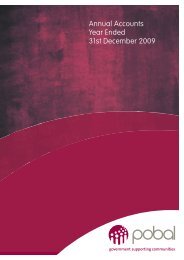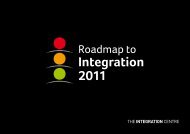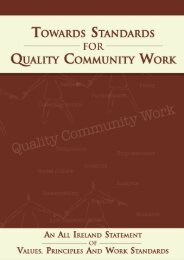Intercultural Education in the Post-Primary School - National Council ...
Intercultural Education in the Post-Primary School - National Council ...
Intercultural Education in the Post-Primary School - National Council ...
You also want an ePaper? Increase the reach of your titles
YUMPU automatically turns print PDFs into web optimized ePapers that Google loves.
ASSESSMENT AND CULTURAL DIVERSITY 7In <strong>the</strong> past, <strong>the</strong> ma<strong>in</strong> purpose of assessmentthroughout post-primary school<strong>in</strong>g was tomeasure and rank what students hadlearned, and <strong>in</strong>deed this model is stillwidely used, particularly <strong>in</strong> formal stateexam<strong>in</strong>ations. This model relies ma<strong>in</strong>ly onsummative assessement which givesstudents marks or grades based on howmuch <strong>the</strong>y have learned or <strong>the</strong> knowledgeand skills <strong>the</strong>y can demonstrate <strong>in</strong> anexam<strong>in</strong>ation at specific po<strong>in</strong>ts dur<strong>in</strong>g <strong>the</strong>irschool<strong>in</strong>g. The emphasis is on products(<strong>the</strong> presentation of <strong>the</strong> ideas, facts, etc.)ra<strong>the</strong>r than on <strong>the</strong> process (how <strong>the</strong>students set about collect<strong>in</strong>g, organis<strong>in</strong>gand <strong>in</strong>terpretat<strong>in</strong>g <strong>the</strong> <strong>in</strong>formation).Elizabeth Coelho, po<strong>in</strong>ts to <strong>the</strong> limitationsof such a narrow approach:The measurement and rank<strong>in</strong>g model isbased on an implicit belief that not allstudents have ‘what it takes’ to besuccessful, and <strong>the</strong> job of <strong>the</strong> school is tof<strong>in</strong>d those who do, and to nurture <strong>the</strong>m.Closer exam<strong>in</strong>ation often shows that ‘whatit takes’ consists of proficiency <strong>in</strong> <strong>the</strong>language of <strong>in</strong>struction, congruencebetween <strong>the</strong> cultural values andexperiences of <strong>the</strong> home and thosepromoted <strong>in</strong> <strong>the</strong> school, educated parents,and higher socioeconomic status.(Teach<strong>in</strong>g and Learn<strong>in</strong>g <strong>in</strong> Multicultural<strong>School</strong>s - An Integrated Approach, 1998)While schools and teachers are now moreaware of <strong>the</strong> need to help all studentsatta<strong>in</strong> high standards of academicachievement and <strong>the</strong>y recognise thatstudents’ understand<strong>in</strong>g, skills andachievements cannot be easily categorised<strong>in</strong>to one box or summed up <strong>in</strong> a s<strong>in</strong>glegrade, <strong>the</strong> predom<strong>in</strong>ance of writtenexam<strong>in</strong>ations that are heavily weightedtowards knowledge recall make it difficultto measure students’ performance over aperiod of time.There is a grow<strong>in</strong>g awareness of <strong>the</strong> specialdifficulties associated with assess<strong>in</strong>gstudents from m<strong>in</strong>ority and immigrantpopulations.<strong>Intercultural</strong> <strong>Education</strong> <strong>in</strong> <strong>the</strong> <strong>Post</strong>-<strong>Primary</strong> <strong>School</strong> 91








